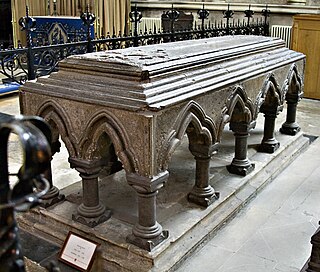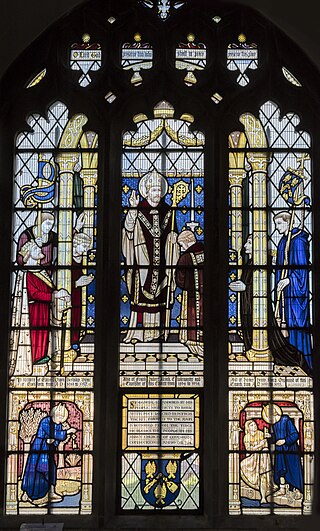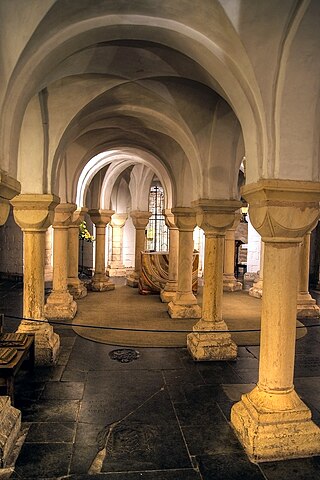Related Research Articles
William de Corbeil or William of Corbeil was a medieval Archbishop of Canterbury. Very little is known of William's early life or his family, except that he was born at Corbeil, south of Paris, and that he had two brothers. Educated as a theologian, he taught briefly before serving the bishops of Durham and London as a clerk and subsequently becoming an Augustinian canon. William was elected to the See of Canterbury as a compromise candidate in 1123, the first canon to become an English archbishop. He succeeded Ralph d'Escures who had employed him as a chaplain.
Ralph d'Escures was a medieval abbot of Séez, bishop of Rochester, and then archbishop of Canterbury. He studied at the school at the Abbey of Bec. In 1079 he entered the abbey of St Martin at Séez and became abbot there in 1091. He was a friend of both Archbishop Anselm of Canterbury and Bishop Gundulf of Rochester, whose see, or bishopric, he took over on Gundulf's death.

Philippa of Clarence also known as Philippa Plantagenet or Philippa de Burgh was a medieval English princess and the suo jure Countess of Ulster.

William Giffard, was the Lord Chancellor of William II and Henry I, from 1093 to 1101, and Bishop of Winchester (1100–1129).
Ealdwulf was a medieval Abbot of Peterborough, Bishop of Worcester, and Archbishop of York.

Sewal de Bovil was a medieval Archbishop of York.
Jocelin of Wells was a medieval Bishop of Bath. He was the brother of Hugh de Wells, who became Bishop of Lincoln. Jocelin became a canon of Wells Cathedral before 1200, and was elected bishop in 1206. During King John of England's dispute with Pope Innocent III, Jocelin at first remained with the king, but after the excommunication of John in late 1209, Jocelin went into exile. He returned to England in 1213, and was mentioned in Magna Carta in 1215.

The Bishop of Worcester is the head of the Church of England Diocese of Worcester in the Province of Canterbury, England.

Walkelin was the first Norman Bishop of Winchester. He began the construction of Winchester Cathedral in 1079 and had the Old Minster demolished. He reformed the cathedral's administration, although his plan to replace the monks with priests was blocked by the Archbishop of Canterbury, Lanfranc. Walkelin was important in beginning St Giles's Fair in Winchester and was greatly active in national politics. For example, he signed the Accord of Winchester, was involved in the Council of London in 1075, and sought to resolve a conflict between Anselm of Canterbury and William II. He was regent of England for a few months at the end of his life.
Robert the Lotharingian was a priest who became Bishop of Hereford following the Norman Conquest of England. His writings serve as one of the best sources for information on the process of compiling the Domesday Book, and he may have introduced the abacus to England.
Simon of Wells was a medieval Bishop of Chichester.
Ranulf of Wareham was a medieval Bishop of Chichester.
Simon Montacute was a medieval Bishop of Worcester and Bishop of Ely.
William de Raley was a medieval judge, administrator and bishop. Most historians now believe that he was the author of the great law book Bracton.
Roger Skerning was a medieval Bishop of Norwich.
Richard Wendene was a medieval Bishop of Rochester.
Simon was a medieval Bishop of Worcester.

Egwin of Evesham was a Benedictine monk and, later, the third Bishop of Worcester in England. He is venerated as a saint in the Catholic Church.

Nicholas of Worcester was the prior of the Benedictine priory of Worcester Cathedral from about 1116 until his death. He was born around the time of the Norman Conquest. It is not known who his parents were, but the twelfth-century historian William of Malmesbury wrote that he was "of exalted descent", and the historian Emma Mason argues that he was a son of King Harold Godwinson.
References
- Bethell, D. L. (1969). "English Black Monks and Episcopal Elections in the 1120s". The English Historical Review . 84 (333): 673–694. doi:10.1093/ehr/LXXXIV.CCCXXXIII.673.
- British History Online Bishops of Worcester accessed on 3 November 2007
- Hoskin, Philippa (2008). "Theulf (d. 1123)". Oxford Dictionary of National Biography. Oxford University Press. doi:10.1093/ref:odnb/95182.